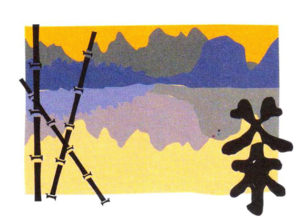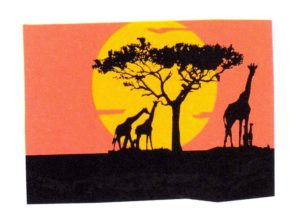Tea-growing regions
The following are the major tea-growing regions in the world:
- Assam
- Himalayas
- Darjeeling
- China
- Niligiris/South India
- Japan
- Ceylon/Sri lanka Africa
- Formosa
- Brazil
- Indonesia
Tea Region Darjeeling
 Darjeeling, on the southern slopes of the Himalayas in northeast India, is unquestionably the tea region par excellence. The most precious of the world’s teas are cultivated in the breathtaking landscape around the small city of Darjeeling. Many of the tea gardens solicit the same respect as the top vineyards of France. Without the shadow of a doubt, this area, nestled high up in the Himalayas, produces the finest, most aromatic, most sought-after teas in the world.
Darjeeling, on the southern slopes of the Himalayas in northeast India, is unquestionably the tea region par excellence. The most precious of the world’s teas are cultivated in the breathtaking landscape around the small city of Darjeeling. Many of the tea gardens solicit the same respect as the top vineyards of France. Without the shadow of a doubt, this area, nestled high up in the Himalayas, produces the finest, most aromatic, most sought-after teas in the world.
Darjeeling teas are cultivated at splendid altitudes of 800-2000 meters, and it is the highest tea gardens that usually produce the best quality tea. Although the region has just the right climate conditions for cultivating fine tea bushes,much depends on how the complex processing is managed.
Th key to “tea-care” at this stage is the care that tea gardens take to ensure the well-being of their workers. A tea garden is organized like a township. The tea garden’s employees (on average,900-2000) live with their families within the tea garden. Facilities such as housing, hospitals, and school are available, and the services of these social facilities are free of charge for the family members.
From November until March, tea production is at a standstill. But when the mountain sun awakens the first shoots in March, harvesting beings, and the first flush is proceeding within 4-6 weeks. A good first flush tastes delicate, flowery-fresh and has a fine tangy flavor.
At the beginning of the season, the daily production can reach 125-150 kg of processed tea. During the course of the year the production levels increase considerably. The first flush is always a gamble for any tea garden. If truly excellent, it can command the highest prices on the world market. In early April, depending on the weather, the “in between” seasonal leaves are harvested. They integrate some of the character of the first flush while foretelling the highly aromatic, nutty, strong second flush harvested from the end of May until the end of June. The color in the cup is a yellowish russetbrown. After the second flush season, the big monsoon season begins. This harvest (July-September) is productive, but not always of the best quality. However,in October,after the rainy season,”excellence”in tea takes precedence once again.Autumn teas are typically characterized bylight aroma and very pleasant flavor.
Tea Region Niligiris /South India
 In the south of India tea is cultivated in the hilly uplands of the states of Karnataka, Kerala and Tamil Nadu at alititudes of 800 to 2000 meters. During the dry season,around the turn of the year,this takes on a fine, delicate lemon flavor. It has a flavor that is lively, fresh and mild. Nilgiri tea, originally grown around the forests of the area, is mainly cultivated by small farmers. The main tea growing regions here are Wayand, Niligiris, Munnar, Anamalais & Travancore. A majority of the teas from here are of the CTC type. The wide range of teas produced here find favour with exporters, blenders and internal markets all through the year. Some of the CTC teas produced here are very good replacements for their North Indian counterparts. The high elevation Orthodox teas manufactured here are forward contracted by exporters for the European markets and seldom do they find their way into the auction channels.
In the south of India tea is cultivated in the hilly uplands of the states of Karnataka, Kerala and Tamil Nadu at alititudes of 800 to 2000 meters. During the dry season,around the turn of the year,this takes on a fine, delicate lemon flavor. It has a flavor that is lively, fresh and mild. Nilgiri tea, originally grown around the forests of the area, is mainly cultivated by small farmers. The main tea growing regions here are Wayand, Niligiris, Munnar, Anamalais & Travancore. A majority of the teas from here are of the CTC type. The wide range of teas produced here find favour with exporters, blenders and internal markets all through the year. Some of the CTC teas produced here are very good replacements for their North Indian counterparts. The high elevation Orthodox teas manufactured here are forward contracted by exporters for the European markets and seldom do they find their way into the auction channels.
During the winter season speciality teas produced in small quantities find favour into niche internal and export markets mainly purchased by boutique tea shops. A small handful of producers also make green teas & organic teas throughout the year which are becoming increasingly popular from here.
Tea Region Ceylon/Sri Lanka
 The tea of present-day Sri Lanka is called traditionally by the old country name Ceylon. At around 60% of its net export profits, tea is the most important export of Sri Lanka, a land of mild, subtropical climate and diverse vegetation. The most important tea-growing areas are located in the central highlands. Ceylon tea is divided into three categories: Low grows tea that grows under 650 meters, medium grown tea that grows between 650 and 1300 meters, and high grown tea that grows between 1300 and 2500 meters. There are three tea districts in the central highlands around Adam’s Peak: Uva in the east, Dimbula in the west, and Nuwara-Eliya in between. Monsoon and passat winds determine the periods of quality. In the Uva district the best full, strong, tangy teas grow between June and September. In the Dimbula district the teas containing less tannin are harvested between December and March and have a softer, lighter cup than the Uva tea.
The tea of present-day Sri Lanka is called traditionally by the old country name Ceylon. At around 60% of its net export profits, tea is the most important export of Sri Lanka, a land of mild, subtropical climate and diverse vegetation. The most important tea-growing areas are located in the central highlands. Ceylon tea is divided into three categories: Low grows tea that grows under 650 meters, medium grown tea that grows between 650 and 1300 meters, and high grown tea that grows between 1300 and 2500 meters. There are three tea districts in the central highlands around Adam’s Peak: Uva in the east, Dimbula in the west, and Nuwara-Eliya in between. Monsoon and passat winds determine the periods of quality. In the Uva district the best full, strong, tangy teas grow between June and September. In the Dimbula district the teas containing less tannin are harvested between December and March and have a softer, lighter cup than the Uva tea.
In the Nuwara-Eliya district good- quality tea is harvested all year round. This tea tastes similar to that of Dimbula and has a typical lemon bouquet. In the highlands more than 90% of tea production is processed as broken tea. For this reason one finds excellent. Ceylon broken tea quite often, but good Ceylon leaf tea less frequently.
Tea Region Formosa
 Since 1870, present-day Taiwan produces green and black teas that bear the island’s former name: Formosa. In the mountainous rural areas to the north and north east, tea is cultivated by about 100 relatively small tea companies. Taiwan can thank the excellent reputation of the semi-fermented Oolong tea for its success as a “tea region”. With its strikingly unusual flavor, this tea takes its age-old name “Oolong” from the Chinese word meaning “Black Dragon”. Both in the production and flavor, it sits right between Green tea and Black tea. Through very careful manual processing, a slight oxidation is attained.If you take a look at the leaves when brewed: the young shoots and leaves unfold completely.
Since 1870, present-day Taiwan produces green and black teas that bear the island’s former name: Formosa. In the mountainous rural areas to the north and north east, tea is cultivated by about 100 relatively small tea companies. Taiwan can thank the excellent reputation of the semi-fermented Oolong tea for its success as a “tea region”. With its strikingly unusual flavor, this tea takes its age-old name “Oolong” from the Chinese word meaning “Black Dragon”. Both in the production and flavor, it sits right between Green tea and Black tea. Through very careful manual processing, a slight oxidation is attained.If you take a look at the leaves when brewed: the young shoots and leaves unfold completely.
They are visibly fermented on the outer edges of the leaves, therefore darker at the rim. Their flavor is sometimes reminiscent of the aroma of a peach; mildlyaromatic, with a full bouquet. The first flush of the year begins a traditionally on April 20th, and reaches its peak on May 6th. During this period. the good quality “Fancy Oolong” is harvested, and occasionally achieves higher prices than the most expensive “Darjeeling”. We recommend that you prepare this wonderful tea with filtered water. It has its own delicate sweetness; so no need for Sugar.
Tea Region Indonesia
 The first tea that arrived in Europe in the 17th century was transported by junk(small boat) to Bantam on java, then loaded onto the large ships of the Eat India Company. The tea gardens on java and Sumatra harvest all year around. Java shows a distinct peak in quality in the months July to October (the dry season). During this period, the quality and flavor of Javanese tea is comparable to a good-quality,mild Ceylon tea.
The first tea that arrived in Europe in the 17th century was transported by junk(small boat) to Bantam on java, then loaded onto the large ships of the Eat India Company. The tea gardens on java and Sumatra harvest all year around. Java shows a distinct peak in quality in the months July to October (the dry season). During this period, the quality and flavor of Javanese tea is comparable to a good-quality,mild Ceylon tea.
By contrast, Sumatra produces more or less uniform teas of plain medium quality all year around. They are reminiscent of North India varieties harvested later in the year. Indonesian teas are usually processed in mixtures for-example, for the East Frisian or British markets. Most tea gardens have chosen to specialize in producing for bulk markets, where conventional production methods are preferred.
Tea Region Himalayas
 The tea-growing areas of the Himalayas that are particularly worth mentioning are Terai and Dooars, both south of Darjeeling, but at an altitude of only a few hundred meters. Tea form Terai usually has well-processed, leaves and a spicy, slightly sweet taste. For the last few years, certain tea gardens, have been producing, a first flush of exceptional quality in February. The tea is produced in the style of Darjeeling. It has a very bright,almost green color in the cup and its flavor has a slight bite to it; fresh,aromatic, and finely brisk.
The tea-growing areas of the Himalayas that are particularly worth mentioning are Terai and Dooars, both south of Darjeeling, but at an altitude of only a few hundred meters. Tea form Terai usually has well-processed, leaves and a spicy, slightly sweet taste. For the last few years, certain tea gardens, have been producing, a first flush of exceptional quality in February. The tea is produced in the style of Darjeeling. It has a very bright,almost green color in the cup and its flavor has a slight bite to it; fresh,aromatic, and finely brisk.
For a long time the kingdom of Sikkim,Bhutan and Nepal were not important to tea importers, because they produced only enough for domestic consumption. Bhutan is virtually untapped. But in Nepal,since the privatization of many of the tea gardens, growing conditions and efficiency have taken a giant leap forward and they are now producing finer, fresher types of tea-distinctly reminiscent of Darjeeling varieties.
Tea Region China
 China is reputed to have the oldest tea traditions. Cultivated in china for circa 5000 years, Green tea was first mentioned in writing around 600 B.C and later described fully in the works of the poet LuYu in 780 A.D. So for many centuries.Green tea has been enjoyed by the Chinese as a healthy and vitalizing drink. Most Green teas and semi-fermented Oolong teas come from the provinces Anhui, Zhejiang and Fujian. But for all its good qualities, Green tea takes some getting used to when it comes to the western palate. Preparation is critical to the flavor, as indeed to its beneficial effects.
China is reputed to have the oldest tea traditions. Cultivated in china for circa 5000 years, Green tea was first mentioned in writing around 600 B.C and later described fully in the works of the poet LuYu in 780 A.D. So for many centuries.Green tea has been enjoyed by the Chinese as a healthy and vitalizing drink. Most Green teas and semi-fermented Oolong teas come from the provinces Anhui, Zhejiang and Fujian. But for all its good qualities, Green tea takes some getting used to when it comes to the western palate. Preparation is critical to the flavor, as indeed to its beneficial effects.
China also produces Black tea in considerable quantities for its export markets, but it is rarely drunk by the Chinese themselves. Various kinds of Black tea are produced, e.g. From the provinces Yunnan,Hunan and Sichuan. Generally,they have a mild, sweet to spicy and slightly smoky flavor. China is the only country that produces specialties such as Jasmine, Rose and Lycheee.
Tea Region Japan
 Tea spread throughout Japan after it was brought there in the 8th century from China by a Buddhist monk. The First tea garden was located on Japan’s largest lake, Biwa-ko. The most important tea-growing district is Shizuoka, which lies in picturesque surrounding at the foot of the Holy mountain Fuji. Almost half of Japan’s entire production is picked here, especially Sencha tea. Other important areas are Kagoshimia on the island of Kyushu and Uji district of Kyoto. The latter supplied the famous “Emperor tea” centuries ago, and today provides the world market with the very best of Japanese Green teas, “Gyokuro”, as well as the best of the “Sencha” variety. Japan produces solely Green tea, but the sheer variety of qualities and price is enormous. No two Senchas are the same, and an excellent Sencha can attain the quality and command the price of an inferior “Gyokuro”. There is only one hard and fast rule, which applies to each of the “Bancha”,”Sencha” and “Gyokuro” strains: the darker green the leaves, the higher the quality. Green tea contains vitamins and traces of important minerals. Because the teein it contains is more active, it is more stimulating than Black tea.
Tea spread throughout Japan after it was brought there in the 8th century from China by a Buddhist monk. The First tea garden was located on Japan’s largest lake, Biwa-ko. The most important tea-growing district is Shizuoka, which lies in picturesque surrounding at the foot of the Holy mountain Fuji. Almost half of Japan’s entire production is picked here, especially Sencha tea. Other important areas are Kagoshimia on the island of Kyushu and Uji district of Kyoto. The latter supplied the famous “Emperor tea” centuries ago, and today provides the world market with the very best of Japanese Green teas, “Gyokuro”, as well as the best of the “Sencha” variety. Japan produces solely Green tea, but the sheer variety of qualities and price is enormous. No two Senchas are the same, and an excellent Sencha can attain the quality and command the price of an inferior “Gyokuro”. There is only one hard and fast rule, which applies to each of the “Bancha”,”Sencha” and “Gyokuro” strains: the darker green the leaves, the higher the quality. Green tea contains vitamins and traces of important minerals. Because the teein it contains is more active, it is more stimulating than Black tea.
Tea Region Africa
 Africa, a comparatively “young” tea growing nation, produce around 15% of the world’s tea. The tea that is produced is almost exclusively CTC (cut,tear,curl) tea for the British market. Highland tea, e.g.From Kenya, can achieve an excellent quality in the best plucking season (December to March) but unfortunately, these days, it is rarely produced in the traditional manner.
Africa, a comparatively “young” tea growing nation, produce around 15% of the world’s tea. The tea that is produced is almost exclusively CTC (cut,tear,curl) tea for the British market. Highland tea, e.g.From Kenya, can achieve an excellent quality in the best plucking season (December to March) but unfortunately, these days, it is rarely produced in the traditional manner.
Rooibush tea: (aka “Redbush tea” or “Roiboos tea”): Rooibush (redbush)from South Africa is a shrub similar to the tea bush. Its red leaves yield a herbal tea with a bright,aromatic color in the cup and a smooth sweetness. Rooibush tea is a popular national drink in South Africa, drunk hot or cold , at any time of the day or evening. Unlike Black tea, Rooibush tea is low in tannin, has no hint of bitterness and is teein-free.
Honey bush tea (aka”Mountain tea” or “Cape tea”): In South Africa, its country of origin, Honey bush tea,with its natural honey-like sweetness and flavor, is preferred over Black tea. The fried leaves contain little tannin and only the tiniest residues of teein, so it may be classed as “teein free”; perfect for the late hours.
Tea Region Brazil
 The “green gold of the Indios” is obtained from the leaves of the evergreen mate shrub; the leaves are sold either green or roasted. Mate contains teein. Just as in the process for Black or Green tea, Mae is withered and dried, and the length of brewing time means that mate tea will have a stronger, more stimulating effect and a less hard taste. In South America the locals drink mate tea from original drinking bowls know as “cuia” that are made from hollowed-out gourds. According to the custom of the gauchos, tea “cuia” is passed on to the other guests, and the bombilha must not be usedn for stirring otherwise it becomes clogged. Mate tea leaves can be used several times by brewing then again with hot water according to taste, and this can easily be done in the European manner of preparing tea, which is recommended in the individual product description.
The “green gold of the Indios” is obtained from the leaves of the evergreen mate shrub; the leaves are sold either green or roasted. Mate contains teein. Just as in the process for Black or Green tea, Mae is withered and dried, and the length of brewing time means that mate tea will have a stronger, more stimulating effect and a less hard taste. In South America the locals drink mate tea from original drinking bowls know as “cuia” that are made from hollowed-out gourds. According to the custom of the gauchos, tea “cuia” is passed on to the other guests, and the bombilha must not be usedn for stirring otherwise it becomes clogged. Mate tea leaves can be used several times by brewing then again with hot water according to taste, and this can easily be done in the European manner of preparing tea, which is recommended in the individual product description.
